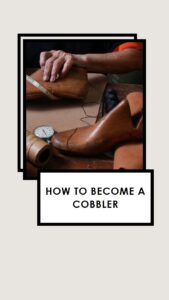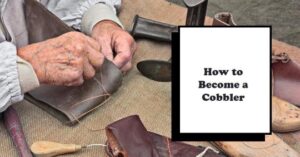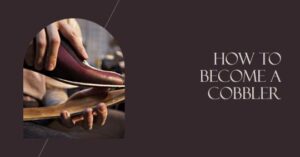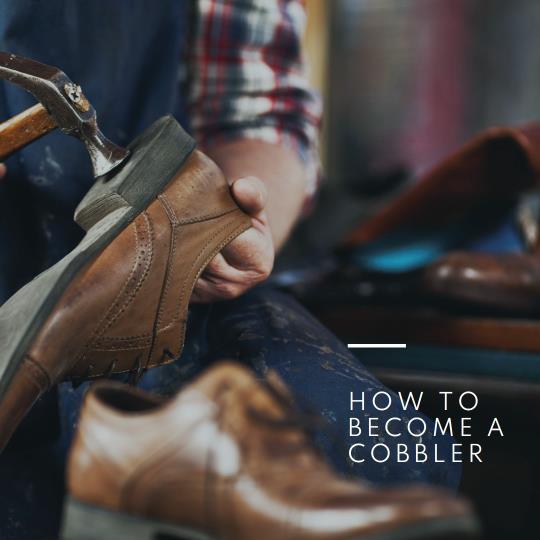Table of Contents
- 1 How to Become a Cobbler – Start Your Journey to Boot Repair Mastery
- 2 Skills and Knowledge Required to Become a Cobbler
- 3 Education and Training for a Cobbler
- 4 Tools and Equipment Needed to Become a Cobbler
- 5 Finding Work as a Cobbler
- 6 Industry Trends and Challenges
- 7 Frequently Asked Questions: How to Become a Cobbler
- 7.1 What is a cobbler?
- 7.2 What type of education do I need to become a cobbler?
- 7.3 How long does it take to become a cobbler?
- 7.4 Can I start my own shoe and boot repair shop as a cobbler?
- 7.5 Is the cobbler profession in demand?
- 7.6 What tools does a cobbler use?
- 7.7 Can cobblers make custom boots?
- 7.8 Is there a certification for cobblers?
- 7.9 How much can I expect to earn as a cobbler?
How to Become a Cobbler – Start Your Journey to Boot Repair Mastery
So you want to learn how to become a cobbler. Maybe you like working on shoes as a hobby, maybe you want to learn how to work on boots, or maybe you are looking for a career in a trade where you will make and work on something that lasts. Cobblers can check off all of those boxes.
The journey to becoming a cobbler will see you join a history of craftsmanship and preservation the age-old tradition of shoe repair. This can be a rewarding career path where you will have the opportunity to work in different types of – from shoe manufacturers and retail stores to opening your own business with your very own shoe and boot repair shop.
A common first step towards beginning a career in cobbling it to gain the right combination of education and hands-on experience. Some community colleges and tech institutes offer classes in shoe repair or leatherworking. This is also still a field where you see that apprenticeship opportunities or mentoring relationships with experienced cobblers be important entry points. These can help you to develop your skills and further your understanding of the trade with on the job training.
The wide world of cobbling offers more than just opportunities in shoe repair – you can diversify your skill set in many ways. From learning about other leather goods and their care or adding on complementary services like boot fitting there are ways to gain versatility that will help increase your success in the industry and keep the doors of opportunity open.

Skills and Knowledge Required to Become a Cobbler
Basic Shoe Construction
In order to become a cobbler you will first need to learn and develop an understanding of basic shoe construction. This includes areas such as the ability to both recognize and work with various shoe components including the sole, insole, outsole, welt, and upper. You should familiarize yourself with the different types of footwear and their construction methods and will learn to use essential cobbler tools including hammers, knives, and sewing equipment. This will provide a foundation for your journey to create and repair shoes. The mastery of some basic techniques will provide you with the foundation for your future cobbler career.
Leatherworking Techniques
Learning how to work with leather is a must know aspect of cobbling so tuning up your leatherworking skills is a must do. You should learn how to cut, shape, and sew leather, as well as how to dye, finish, and care for it properly. In addition to these basics you will need to understand the differences between the various types of leather and when to use them in your boot or shoe designs. Gaining further experience with both hand-stitching and machine-stitching techniques can ensure you have the skills needed to create durable, high-quality footwear.
Understanding of Foot Health
If you are going to be able to create both comfortable and functional boots then you are going to have to have a solid understanding of foot health and what impacts it. You should familiarize yourself with common foot problems, including bunions, plantar fasciitis, and flat feet, and then learn how proper footwear can help alleviate or aggravate these issues. If you develop an awareness of how the different shoe shapes, sizes, and materials can affect a person’s comfort you will be better armed to create or repair their boots. When you integrate this knowledge into the construction of your shoes and boots, you can create products that promote the satisfaction of your customers.

Education and Training for a Cobbler
Formal Education
If your journey to becoming a cobbler will go the route of formal education then you will want to start out with a high school diploma or equivalent as this is usually a minimum requirement to enter shoe and boot making programs. This path takes you into a cobbling or cordwaining program at a vocational or trade school. Some of these schools offer classes in areas like shoe repair or leatherworking as part of their fashion design departments.
Apprenticeship
Apprenticeships are both a valuable and also common way to gain the practical experience needed by learning from an expert in the field. This is a very common path followed by aspiring cobblers who opt for these apprenticeships to both enhance their skills and knowledge whether it is a supplement for or a replacement to formal education. The hands-on training that comes with apprenticing under an experienced cobbler will allow you to familiarize yourself with various tools, materials, and techniques used in the boot and shoe repair process and ensure you get to practice on real-life projects.
Online Resources
Another great choice to add in addition to formal education and apprenticeships is to harness the power of the web. There are numerous online resources available for those seeking to acquire or refine their skills in shoemaking. Internet courses and training have been growing for a while and continued the uptrend in recent years. These online courses and programs can provide you a flexible schedule to suit your availability and allow you to work at your own pace.
In addition, there are also online resources that offer certification programs to contribute to your credibility as a professional cobbler. Another use of the internet is to network with other professionals for example by engaging in online forums around cobbling.
When you take the time and effort to invest in yourself with education and practical training then you are setting yourself up right for a successful career in the world of shoe and boot repair and design. By embracing the learning opportunities available you can make progress as you seek to find the right balance between theoretical knowledge and hands-on experience.

Tools and Equipment Needed to Become a Cobbler
Hand Tools
One of the first things you will need to start out right on your journey as a cobbler are hand tools needed for the job. These will include measuring tapes, specialized needles for leather, cutting tools such as shears and rotary cutters, and hammers and mallets for shaping and forming leather. Other hand tools like awls, lasting pliers, and bone folders can be used for stitching, pulling leather over shoe lasts, and making creases in material. You’ll want to keep plenty of spare needles around as even heavy-duty needles can break when working with thick layers of leather.
Machinery
Machinery is where you will start to go from a hobbyist to a professional. There are numerous machines that a cobbler’s workshop should be equipped with if you want to increase efficiency and produce high-quality results. The cost for this can be significant and depending on your choice of machinery and whether you buy new or used equipment you may spend anywhere from $25,000 to $60,000 to outfit your shop. Essential machines can include sewing machines with attachments made for working with leather, skiving machines to thin out leather edges, and sole press machines for attaching soles securely. In addition, you may want to have buffing and finishing machinery to help achieve a polished and professional appearance on your footwear.
Shoe and Boot Lasts
Shoe lasts are of critical importance to the process of making and repairing boots or shoes. These are forms that are usually made from wood, plastic, or metal, that are shaped like a foot and are used by cobblers as a template to either create or reconstruct footwear. Lasts are available in various sizes, widths, and shapes in order to cater to the many different foot types and styles. You will find that the acquisition of a broad collection of shoe lasts in a range of sizes and styles will enable you to produce accurate, comfortable, and professional-looking shoes in your cobbler career.
Becoming familiar with cobbling related tools and equipment and the related investment as needed, is a milestone on your way to establishing a successful career as a cobbler.

Finding Work as a Cobbler
Job Opportunities
As a cobbler, you will find multiple options for employment. Among those are working with shoe manufacturers, shoe stores, or positions in established shoe repair shops. As apprenticing and OJT are common in the cobbling field you can consider contacting reputable cobblers in your area. You may find someone who is willing to provide on-the-job training or to take you on as an apprentice.
Self-Employment
One of the nice options with being a cobbler, like many of the jobs in the trades, is that you can start up your own business. If being your own boss sounds like the way you want to go you can consider starting up your own shoe repair workshop.
You will want to consider the cost of doing this. As mentioned a few paragraphs ago the cost of machinery can be substantial. In addition, you’ll need to budget for back room materials and retail items, such as polishes, laces, and insoles. While this route does require some amount, possibly a significant amount, of upfront investment, it does also potentially offer greater earnings and more flexibility in the long run.
If you decide to start your own cobbler business you will want to be sure to develop a strong network of contacts and clients through local advertising and word-of-mouth referrals. Focus on building up a reputation for quality work and exceptional customer service which will be essential for your success in this field.
Industry Trends and Challenges
The latest industry trends and challenges will be of note for you as you consider becoming a cobbler. For example, one trend in the shoe and boot making industry is that there is an increased demand for custom, handcrafted shoes. In today’s world of commodity products and look alikes, many customers will also appreciate products that are hand made with care and attention to detail. In order to capitalize on this space you must be proficient in the specialized techniques and be able to produce high-quality products that cater to this niche market.
One of the other accelerating trends is the importance of sustainability and eco-friendly practices being sought by consumers. Many people seek footwear that is made from ethically sourced materials and environmentally friendly processes. You will want to stay up to date about sustainable fabrics and materials and embrace eco-friendly practices in your work to capitalize on this trend.
As to challenges for cobblers they face lots of competition from both low-cost imported shoes and the growing accessibility of affordable new footwear. These low-cost items can minimize the feasibility of paying for repairs which challenge cobbler businesses. It is the conundrum that in order to stay relevant in the broad consumer market, you must keep your prices low without compromising the quality of your services. This is why specializing in repairing high-end, expensive shoes or cowboy boots can be a very viable strategy to maintain a steady flow of clientele who are willing to invest in maintaining their footwear.
Frequently Asked Questions: How to Become a Cobbler
What is a cobbler?
A cobbler is a skilled tradesperson that specializes in the skill of repairing shoes, boots, and sometimes other leather goods. They may also design and hand-make shoes or boots.
What type of education do I need to become a cobbler?
It is important to know that there isn’t any one specific educational requirement to become a cobbler. In fact, most cobblers learn the trade through an apprenticeship or on-the-job training. With that being said, there are some vocational schools that offer shoe repair or related courses, which can provide a formal education in the field.
How long does it take to become a cobbler?
The length of time it takes to become a cobbler can vary depending on your method of learning and how fast you master the craft. It is common for an apprenticeship to last anywhere from 1 to 3 years, while further on-the-job training duration can greatly vary. That is to get started – truly mastering the trade to the point of being able to perform complex repairs or create custom footwear can take several years of practice.
Can I start my own shoe and boot repair shop as a cobbler?
Yes, you can. In fact, many cobblers do eventually start their own businesses and is one appeal of the career choice. Starting your own shop does allow for more freedom and flexibility, but also requires gaining additional skills like business management, customer service, and marketing. You may want to consider gaining some experience and building a reputation in the trade before taking on the challenge of running your own shop.
Is the cobbler profession in demand?
One thing is for sure – as long as people wear shoes and boots, there will be some level of demand for shoe and boot repair. However, it is also true that the prevalence of cheap, mass-produced footwear has caused some decrease in demand for professional cobblers. You can be sure that there will always be someone whose dog chewed their cowboy boots or someone who wore their cowboy boots in snow who will need a cobbler.
What tools does a cobbler use?
Cobblers will use a wide variety of tools as they practice their craft. These will include hammers, pliers, knives, scissors, shoe lasts, brushes, and sewing machines.
Can cobblers make custom boots?
Yes, in addition to shoe repairs some cobblers also have the skills needed to also design and hand-make boots. This is a more advanced skill to repairs and requires a deep understanding of foot anatomy, pattern-making, and boot construction techniques. This is a more advanced skill that not all cobblers possess, but it can be learned with time and experience.
Is there a certification for cobblers?
While there is no mandatory certification to become a cobbler, professional certification programs do exist. These can help to demonstrate a cobbler’s competency and commitment to the trade. As one example, The Shoe Service Institute of America (SSIA), offers a Certified Master Craftsman program.
How much can I expect to earn as a cobbler?
Any estimates of income can vary widely based on experience, location, whether you’re self-employed or working for another business, and numerous other factors. In 2021, the average salary for a cobbler in the United States was around $25,000 to $30,000 per year. This is an average number and more experienced cobblers – especially those who are owners of their own businesses, have the potential to earn significantly more.
You can watch a Youtube video that is based on a summary of this article by going here: https://youtu.be/9rEELaFSLxI

